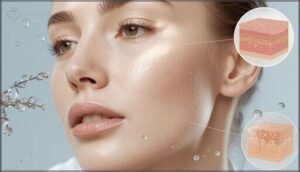This site is supported by our readers. We may earn a commission, at no cost to you, if you purchase through links.

Your bathroom cabinet tells a story—some products sit untouched while others run out faster than you can replace them. That disconnect often stems from one fundamental issue: misunderstanding your skin’s actual needs. Nearly 60% of people incorrectly identify their skin type, which means they’re treating oily skin like it’s dry, or slathering heavy creams on faces that need something lighter.
Your genes shape much of your skin’s behavior, controlling everything from how much oil your glands produce to how quickly moisture evaporates. But hormones, climate, stress, and even your morning coffee can shift things temporarily.
Learning to read your skin’s signals—the shine patterns, texture changes, and how it feels an hour after washing—gives you a reliable framework for choosing products that actually work with your biology instead of against it.
Table Of Contents
Key Takeaways
- Nearly 60% of people misidentify their skin type, leading them to use products that work against their skin’s natural biology rather than supporting it.
- Your skin type is determined by sebum production, genetics (which control up to 60% of aging and pigmentation), and environmental factors like climate, stress, and UV exposure—all of which can shift over time.
- The blotting sheet test and visual inspection of shine patterns, pore size, and texture an hour after washing provide reliable at-home methods to identify whether your skin is oily, dry, combination, normal, or sensitive.
- Matching products to your actual skin type—like using salicylic acid for oily skin or ceramide-rich formulas for dry skin—prevents common issues, reduces wasted money, and requires seasonal adjustments as your skin’s needs change throughout the year.
What Determines Your Skin Type?
Your skin type isn’t something you pick—it’s determined by a mix of biological and environmental factors working together. At the core of it all is sebum, the natural oil your skin produces, but that’s just the beginning.
Let’s look at the key elements that shape whether your skin leans oily, dry, or somewhere in between.
Role of Sebum Production
Your skin type hinges on sebum—an oily substance your sebaceous glands produce. Sebum composition includes triglycerides, wax esters, and squalene, which protect your skin.
Hormonal influence, especially during puberty, ramps up sebum production, often leading to oily skin. Regional variations matter too—your T-zone usually produces more sebum than your cheeks.
Environmental factors like humidity and stress also shift sebum levels, affecting skin type classification. Excess sebum can lead to clogged pores, trapping dirt and bacteria.
Genetic and Environmental Influences
Beyond sebum production, your genetic predispositions shape up to 60% of skin aging and pigmentation variations. Environmental stressors like UV radiation and pollution effects compound these influences, accelerating skin conditions and triggering dermatological conditions.
Climate impacts—from altitude to urban air quality—intensify UV exposure and oxidative stress. Pollution can also lead to excess melanin production, resulting in dark spots and uneven skin tone.
That’s why individualized skincare approaches now consider both your inherited traits and environmental factors to address skin concerns effectively and maintain best skin health.
Factors That Can Change Skin Type
While genetics and environment establish a baseline, your skin type isn’t fixed. Hormonal shifts during pregnancy or menopause can reduce moisture by 30% within five years, making previously oily skin dry.
Age influence matters too—sebaceous activity naturally declines over time. Environmental impact from UV and pollution, diet changes affecting oil production, and medication effects all contribute to evolving skin conditions, requiring ongoing skin analysis to maintain best skin health.
Main Types of Skin Explained
Your skin falls into one of five main categories, each with its own set of traits and needs. Knowing which type you have makes it easier to choose products that actually work for you.
Let’s break down what sets each skin type apart.
Oily Skin Characteristics
You’ve probably noticed your face looking shiny by midday—that’s sebum overproduction at work. Oily skin produces excess sebum from enlarged, overactive glands, especially across your forehead, nose, and chin.
This leads to enlarged pores that collect oil and debris, creating a bumpy skin texture with blackheads and blemishes. Hormonal impact from puberty, stress, or menstrual cycles intensifies these symptoms, though pore minimization products can help manage the shine.
Dry Skin Characteristics
When your face feels tight after washing, you’re experiencing xerosis cutis—chronic dryness from NMF deficiency and lipid alterations in your skin’s protective layer. This barrier impairment causes roughness, flaking, and that uncomfortable tightness you can’t ignore.
The pruritus link explains why dry skin itches persistently, creating a cycle that demands proper hydration and moisturizing to restore your skin’s natural balance.
Combination Skin Characteristics
If you’re noticing T-zone oiliness alongside cheek dryness, you likely have combination skin—the most common skin type affecting up to 72% of people. Your facial skin shows distinct zones: enlarged pore size and shine on your forehead, nose, and chin, while your cheeks feel tight or flaky.
Seasonal changes intensify this contrast, with summer amplifying sebum secretion in oily areas. Understanding skin types helps you balance your skin care effectively.
Normal Skin Characteristics
When you’re blessed with normal skin, you’ve hit the genetic jackpot—well-balanced hydration, minimal sensitivity, and even texture characterize this stable skin type. Your skincare becomes straightforward, though understanding skin types helps you maintain this enviable baseline despite aging effects on your stable barrier.
- Balanced hydration levels prevent excessive oiliness or dryness
- Small, barely visible pores contribute to smooth appearance
- Even skin tone remains consistent without frequent blemishes
- Moderate sebum production aids your skin’s natural protection
Sensitive Skin Characteristics
Think of sensitive skin as having a low threshold for irritation—your skin reacts more intensely to everyday triggers like fragrances, harsh weather, or certain ingredients. Nearly half of Americans report sensitive skin concerns, with women experiencing it more frequently.
You’ll notice symptoms like redness, stinging, burning, or itchiness after product application. Proper testing and dermatological advice help identify specific triggers, making management achievable through gentle, fragrance-free formulations adapted to your unique skin type.
How to Identify Your Skin Type
Figuring out your skin type doesn’t require a dermatologist’s expertise—you can do it at home with simple observation techniques. The key is knowing what to look for and when to check.
Let’s walk through three practical methods you can use to identify your skin type today.
Visual Inspection Methods
Your eyes can tell you a lot about your skin type when you know what to look for. Visual inspection involves examining your face in natural lighting, ideally in front of a mirror. Dermatologists use this method to assess key features:
- Shine intensity on your T-zone or cheeks indicates oiliness
- Pore size differences reveal sebum production levels
- Redness detection helps identify sensitivity or inflammation
- Texture analysis shows dryness, smoothness, or roughness
This skin analysis provides immediate clues for understanding skin type.
The Blotting Sheet Test
Want a quick way to check your sebum levels? The blotting sheet test offers practical skin analysis you can do at home. Press an absorbent paper on your facial skin for a few seconds, then hold it to the light.
Sheets saturated with oil indicate oily skin, while minimal absorption suggests dry skin. Oil concentrated in your T-zone reveals combination skin type.
Signs to Look for at Home
Beyond blotting sheets, your skin tells its own story through daily behaviors. Oily skin signs include shine returning within 30 minutes of washing and enlarged pores across your face. Dryness indicators show up as tight, flaky patches that resist moisturizer. Combination clues reveal a greasy T-zone alongside dry cheeks. Normal skin feel stays balanced without extremes, while sensitive reactions appear as redness or stinging from new products.
Importance of Knowing Your Skin Type
Knowing your skin type isn’t just about satisfying curiosity—it’s the foundation for making smart choices about your skincare routine. When you understand whether your skin is oily, dry, combination, normal, or sensitive, you can avoid wasting money on products that don’t work or, worse, cause irritation.
Knowing your skin type is the foundation for smart skincare choices that save money and prevent irritation
Let’s look at three key reasons why identifying your skin type matters for your daily routine.
Choosing Suitable Skincare Products
When you choose skincare products matched to your skin type, you’re setting yourself up for real results instead of wasted money and frustration. Ingredient suitability matters—what works for oily skin won’t necessarily help dry skin, and individualized skincare means understanding these differences for routine customization.
- Oily skin: Look for lightweight, non-comedogenic moisturizers with niacinamide or salicylic acid that control oil without clogging pores
- Dry skin: Choose richer formulas with hyaluronic acid, ceramides, and emollients that lock in moisture and support barrier repair
- Sensitive skin: Always perform patch testing with fragrance-free, hypoallergenic products before adding targeted treatments
Product layering and skincare product selection become straightforward once you know your skin’s needs.
Preventing Common Skin Issues
Understanding your skin type helps you tackle common skin problems before they start. For acne prevention, you’ll need products that match your sebum levels—oily skin responds well to salicylic acid cleansers, while dryness management requires barrier-protecting moisturizers.
Sun protection matters for all skin types, reducing your skin cancer risk by about 40% with consistent SPF use. Good skincare habits and infection reduction strategies keep your skin healthier long-term.
Adapting Routines to Seasonal Changes
Your skin type doesn’t stay the same year-round, which means your skincare routine shouldn’t either. Winter hydration demands richer moisturizers to combat indoor heating’s drying effects, while summer protection requires lightweight, non-comedogenic formulas as sebum production increases.
Spring exfoliation helps remove winter’s buildup, and autumn repair focuses on restoring damage from UV exposure—adjusting products based on humidity effects keeps your skin balanced through every season.
Skincare Tips for Each Skin Type
Once you know your skin type, the next step is building a routine that actually works for you. Each skin type responds differently to products and techniques, so what helps your friend might not be right for your skin.
Let’s walk through practical, evidence-based tips specific to oily, dry, combination, sensitive, and normal skin.
Best Practices for Oily Skin
If you have oily skin, twice-daily cleansing with gentle, salicylic acid-based formulas helps with sebum control and pore minimization—reducing excess oil by roughly 30%. Your skincare routine should include niacinamide or retinoids for long-term sebum regulation.
Lifestyle adjustments matter too: managing stress and avoiding high-glycemic foods can decrease oiliness by 15-25%, tackling common skin concerns at their source.
Moisturizing Dry Skin Effectively
When your dry skin feels tight or flaky, daily moisturizing makes all the difference. Consistent twice-daily application reduces dryness by up to 80% and keeps your skin hydrated for 24 hours.
Look for products containing:
- Humectants like glycerin and hyaluronic acid to attract water
- Emollients such as ceramides for barrier repair
- Occlusives that lock moisture in
- Fragrance-free formulas for sensitive skin types
This routine interrupts the dry skin cycle effectively.
Balancing Combination Skin
Managing combination skin means treating different zones with targeted care. Apply lightweight, water-based moisturizers to your oily T-zone while using richer formulas on dry cheeks. Multi-masking benefits both areas simultaneously—try clay masks for oiliness and hydrating masks for dryness. Gentle exfoliation once weekly clears pores without irritation.
Your skincare routine needs seasonal adjustments too, since winter increases dryness by 20-30%, requiring hydration balance shifts for best facial skin care.
Caring for Sensitive Skin
Your sensitive skin type needs a protective approach since up to 70% of people globally now experience some degree of sensitivity. Focus on barrier repair through gentle ingredients like niacinamide while avoiding common triggers such as artificial fragrances.
Build soothing routines with fragrance-free moisturizers and mild oil cleansers. If skin concerns persist despite careful product selection, consult a dermatologist for targeted treatment options.
Maintaining Normal Skin Health
Your normal skin benefits from consistency rather than complexity in your facial skin care routine. Maintain this balanced skin type with these daily essentials:
- Daily cleansing twice with gentle, nonfoaming cleansers preserves your protective barrier
- Hydration levels stay ideal at 38-42% moisture content with light moisturizers
- Sun protection using SPF 30+ shields against photodamage daily
- Diet influence matters—prioritize antioxidants and adequate water intake
These lifestyle factors support long-term skin health without overwhelming your naturally balanced complexion.
Frequently Asked Questions (FAQs)
Can skin type change during pregnancy or menopause?
Yes, your skin type can shift dramatically during these life stages. Hormonal fluctuations affect sebum production, often increasing oiliness during pregnancy.
Menopause generally brings dryness and collagen reduction, sometimes warranting HRT effects evaluation.
How does diet affect your skin type?
Your diet directly influences skin type through glycemic load, dietary fats, and hydration. High-sugar foods increase sebum production, worsening oily skin concerns, while antioxidants and omega-3s improve skin health and reduce inflammation naturally.
What role does hydration play in skin?
Hydration strengthens your skin barrier and boosts elasticity, helping prevent dryness and irritation. Drinking enough water improves moisture retention across all skin types, while reducing TEWL impacts overall skin health and appearance.
Do certain medications alter your skin type?
Certain medications can greatly alter your skin type. Corticosteroid effects include thinning and atrophy, while antibiotic dryness and antihistamine impact often cause flaking. Hormonal influence affects oil production, and medication rashes may trigger persistent skin concerns and solutions.
How often should you reassess your skin?
Like a chameleon adapting to its surroundings, your skin changes constantly. Reassess your skin type every three to four months, particularly after seasonal shifts, hormonal influence, lifestyle changes, or when your skincare routine loses effectiveness.
Conclusion
Like finding the right prescription after years of guessing, understanding different skin types transforms your entire approach to skincare. You’re no longer throwing products at problems—you’re working with your skin’s natural tendencies.
That T-zone shine or persistent tightness isn’t a flaw to fight; it’s information guiding smarter choices. When you match products to your actual biology, your routine becomes simpler, your results more consistent, and those untouched bottles finally disappear from your cabinet.











